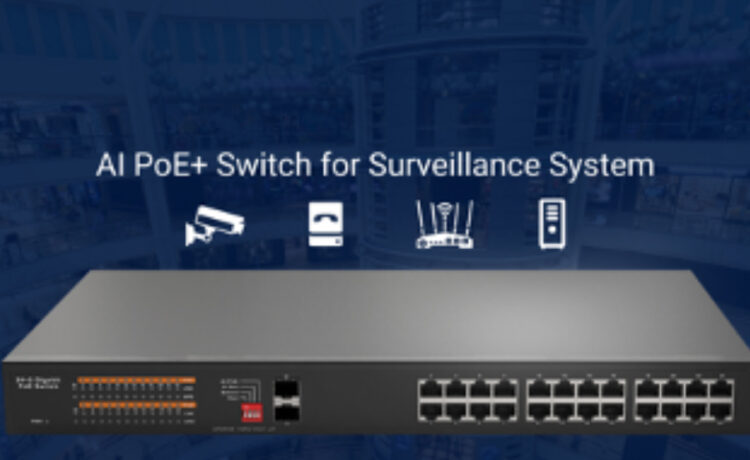By Lucero Artemio, Senior Product Manager, Fiberroad Technology
Using POE switches to reduce IP camera cabling is one of the best ways to reduce your security camera network installation costs. POE is a technology that uses pure copper conductors to transmit data. While many CCTV installers use CCA cables, these are not compatible with POE. Moreover, POE’s standard range is 100 meters, although some models support extended POE, which allows a distance of 250 meters. While POE can be useful for security and surveillance applications, the maximum bandwidth per channel cannot exceed 10MB, which is typically more than sufficient for IP cameras.
Using POE switches to reduce IP camera cabling is an excellent solution for small business and home surveillance. The technology is mature and reliable, and you can expect your cameras to run smoothly for years. The benefits of POE switches include reduced IP camera cabling and reduced installation time. Read on to learn more about this power-over-ethernet technology. It’s easy to install and will save you time and money.
POE Switches are easy to implement
POE switches are designed to support multiple IP cameras in a single system. As a result, you can implement PoE switches without a significant amount of additional hardware. A PoE switch usually features uplink ports for continuous recording of video. It is important to check the manufacturer’s specifications to ensure that a PoE switch supports the right amount of power.
A PoE switch has many benefits. Unlike IP cameras, PoE switches are easy to implement and have an integrated safety feature. They automatically shut off power if the connection is interrupted or if a cable is frayed. They are also easy to maintain and implement, and are available in models with up to 24 ports. They require force-10Mbps full duplex and are easy to install.
POE Switches are a great way to reduce IP camera cabling and reduce the amount of expensive IP camera cabling in your system. You can install a PoE switch in one central location, power your camera from the switch, and monitor the power usage on your PoE switch. You can even monitor the power consumption of IP devices through the PoE management interface. It is important to test your PoE switch before powering your IP camera.
POE Switches cost-effective solution
When installing IP cameras, one of the main issues that you may face is distance. It is not easy to connect IP cameras that are far apart and there are also problems related to power sources and network coverage. With PoE, power and data are transmitted via a single Ethernet cable, but this solution has its limitations. Standard PoE has a distance limit of 100 meters, and you will need to use signal repeaters to extend the range. To overcome this problem, you can purchase a Long Range PoE switch, which has longer distance capabilities.
A PoE switch is a device that connects multiple PoE devices. One PoE switch can provide power to a single IP camera, while another PoE switch can supply power to several cameras. The power supply of each PoE switch varies from 15 W to 30 W. When choosing a PoE switch, you should also check the maximum power supply of the switch, as this will determine how much power it can provide to each device connected.
POE Switches allows for higher speeds
A PoE switch increases the number of ports available for transmission and reduces the complexity of your Ethernet video network. A PoE switch can be connected to the LAN port of a PoE router. The IP cameras can then connect to the different ports on the PoE switch. Typically, a PoE switch can accommodate from one to eight IP cameras. Using a PoE switch is faster and easier than a PoE NVR.
A PoE switch can also be used for smart home automation. This technology provides power and data over the same cable, making it more convenient for businesses to integrate with other home automation systems. Smart home technology may include voice assistants, electric car charging stations, and LED lighting. PoE switches differ from regular switches primarily in accessibility. Regular switches are not PoE enabled, but they can be made to work with PoE by connecting a PoE injector or a PoE splitter.
In many cases, the power requirements of IP surveillance cameras may dictate the type of cable that should be used to connect them. A PoE switch reduces the overall cabling by providing power over the same network cable. This type of technology is available in various models and can be customized to match your needs. Depending on your needs, PoE switches can also help you increase bandwidth and improve the performance of your IP camera network.
POE Switches are easier to scale
If you have more than one IP camera on your network, you can use a PoE switch to reduce cabling. POE switches are devices that provide power to network equipment through a power line. They can power up to 300 feet and allow you to connect multiple cameras to a single switch. The switch itself can provide enough power for up to 250W of power to each camera. Once you have connected all of your cameras, you will only need to connect them back to the network using one ethernet cable.
PoE switches are available in different sizes. You need to find one that has enough ports to connect all of your cameras. For example, if you have eight IP cameras in one network, you will need an 8-port PoE switch. The switch should also have uplink and cascade ports. If you want to have more bandwidth, you can also consider a gigabit switch. This will allow you to use more bandwidth and handle more IP cameras.









